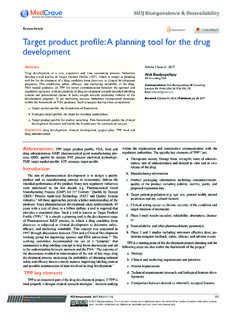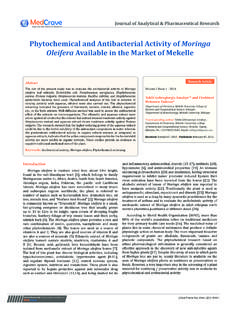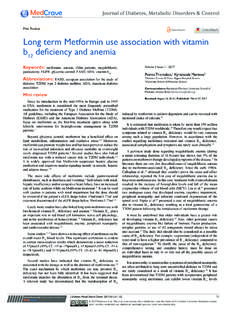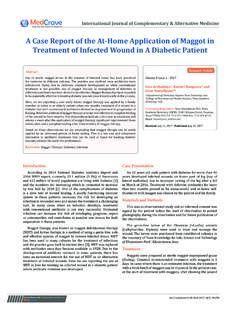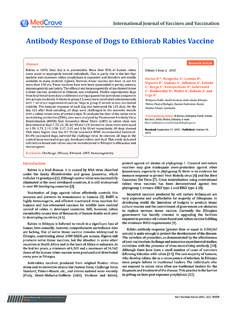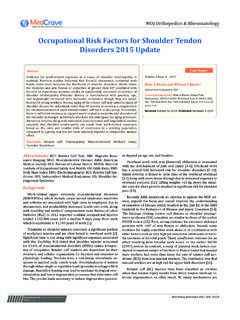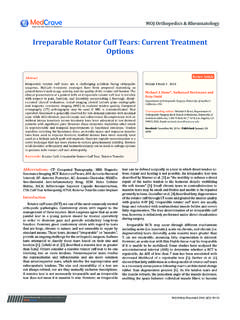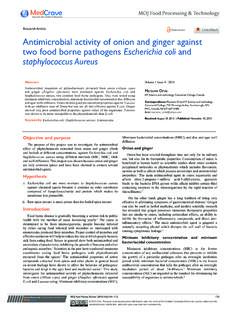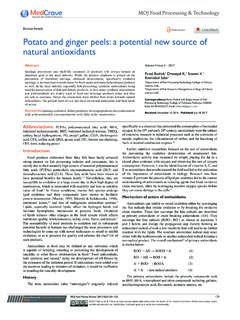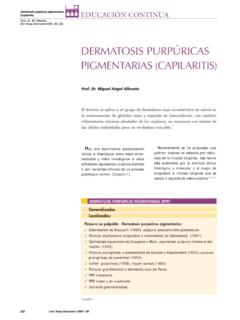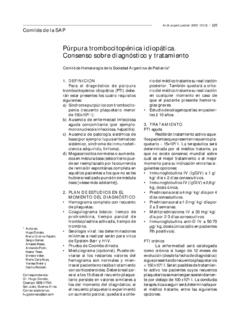Transcription of Purpura Fulminans and Pasteurella Multocida Infection in ...
1 J Anesth Crit Care Open Access 2014, 1(4): 00024 Journal of Anesthesia & Critical Care: Open AccessSubmit Manuscript | : Purpura Fulminans ; DIC: Disseminated Intravascular Coagulation; FFP: Fresh Frozen Plasma; PM: Pasteurella Multocida ; ED: Emergency Department; NA: Noradrenaline; HDFVVC: Continuous Venovenous HemodiafiltrationIntroductionPurpura Fulminans (PF) is a rare syndrome occurring mostly in infants [1,2]. It is a rapidly progressive disease caused by microvascular thrombosis of skin vessels leading to hemorrhagic skin necrosis manifested as characteristic skin lesions [1,3]. Three different subtypes have been described, according to etiology and pathogenesis: neonatal PF, idiopathic PF and acute infectious PF [1,2]. Acute infectious PF occurs in the presence of severe acute Infection , most commonly caused by Neisseria meningitidis, followed by Streptococcus pneumonia [4].
2 Early full spectrum antibiotic, supportive therapy and fresh frozen plasma (FFP) are essential in this subtype of PF with high mortality rate. We describe a case of rapidly progressive acute infectious PF presenting in an adult with Pasteurella Multocida (PM) bacteriemia. With this case report we aim to illustrate the potential life threatening severity of PF and illustrate a rare presentation due to its occurrence Purpura Fulminans and Pasteurella Multocida Infection in an Adult: A Case ReportCase ReportVolume 1 Issue 4 - 2014 Petra Pego M1*, Raquel Cavaco2, T nia Sequeira2 and Luis Bento21 Medicina 3, Hospital Distrital de Santar m, Portugal2 Unidade de Urg ncia M dica, Hospital de S o Jos , Portugal*Corresponding author: Petra Pego M, Medicina 3, Hospital Distrital de Santar m, Urbaniza o do Vapor, Lote 8, 2070-240 Cartaxo, Santar m, Portugal, Tel: +351918863415; Email: Received: September 16, 2014 | Published: October 20, 2014in an adult and to our knowledge unique association with PM PresentationA fifty-nine year-old white female presented to the emergency department (ED) with abdominal pain, nausea, vomiting and diarrhea (> 15 stools/day).
3 The symptoms had begun earlier that day. Patient denied any other symptoms. Patient had past previous history of alcoholic chronic liver disease with associated pancytopenia for hypersplenism, arterial hypertension, ischemic and hypertensive cardiomyopathy, proliferative mesangial glomerulonephrytis, type 1 neurofibromatosis and scleromyxedema. There was history of alcoholic consumption until five years ago. She was previously medicated with folic acid, etoricoxib, omeprazol, estazolam and enalapril/hydroclorotiazide on standard doses. On physical examination tympanic temperature of 36 C, hypotension (75/45 mmHg), tachycardia (108 bpm), jaundice, mild epigastric tenderness and mild bilateral lower limb edema. The remainder physical examination was unremarkable. Laboratory evaluation Table 1 showed deterioration of chronic pancytopenia (hemoglobin 7,6 g/L; leukocytes 3,6 x 109/L; platelets 40 x 109/L), acute renal failure (creatinine 2,6 mg/AbstractIntroduction: Purpura Fulminans (PF) is a rare rapidly progressive disease caused by microvascular thrombosis of skin vessels manifested as characteristic skin lesions.)
4 Three different subtypes have been described: neonatal, idiopathic and acute infectious. Treatment depends on subtype and may include antibiotic therapy, supportive treatment and transfusions [mainly fresh frozen plasma (FFP)]. Case presentation: A fifty nine-year-old female presented at emergency department with nausea, vomit, diarrhea and abdominal pain. She was hypotensive, tachycardic, jaundiced and had mild epigastric tenderness. Analysis revealed pancytopenia, coagulopathy, renal failure and hyperbilirubinemia. Arterial blood gas analyses showed compensated metabolic acidosis and hyperlactacidemia. Patient was started on vasopressor therapy for hypotension unresponsive to fluids. Nevertheless, her condition deteriorated and severe metabolic acidosis developed. A purpuric rash developed initially at left thigh and spread through abdomen and thorax. Patient was transferred to an intensive care unit after resuscitation from a cardiorespiratory arrest.
5 Large spectrum antibiotic therapy and renal replacement technique were started as well as transfusion with platelets, FFP and red blood cells. Susceptible Pasteurella Multocida was present in two hemocultures. Despite maximal supportive treatment patient s condition deteriorated and dyed 72 hours after : We described a case of severe acute infectious PF presenting in an adult with Pasteurella Multocida bacteriemia. The uniqueness of this case report lye on the rarity of PF in adults and on being to our knowledge the first case described of PF caused by Pasteurella Multocida Fulminans ; Adult; Pasteurella multocidaPurpura Fulminans and Pasteurella Multocida Infection in an Adult: A Case ReportCitation: Petra Pego M, Cavaco R, Sequeira T, Bento L (2014) Purpura Fulminans and Pasteurella Multocida Infection in an Adult: A Case Report. J Anesth Crit Care Open Access 1(4): 00024. DOI: : 2014 Petra Pego et ; urea 50 mg/dL), coagulation abnormalities (prothrombyne time 22 ; APTT 52,9 ), mixed hyperbilirubinemia (total bilirubin 2,98 mg/dL; direct bilirubin 1,46 mg/dL) and reactive protein C elevation (36,3 mg/L).
6 Compensated metabolic acidosis and hyperlactacidemia (lactate 5,95 mmol/L) on arterial blood gas analyses. Chest radiography was was admitted at observation room and started on fluid resuscitation with need of noradrenaline (NA) to a maximal dose of 100 mcg/min. Metabolic acidosis and hyperlactacidemia gradually worsened. There was deterioration of mental status and development of a petechial rash at medial side of left thigh. Patient experienced cardiopulmonary arrest (pulseless electric activity for 6 minutes) and was resuscitated with return of spontaneous circulation. Was intubated, mechanically ventilated and transferred to an intensive care unit. At admission she was hypothermic, hypoglycemic, hypotense Table 1: Laboratory evaluation and arterial blood gas : Emergency Room; OR: Observation Room; ICU: Intensive Care Unit; MCV: Mean Corpuscular Volume; MCH: Mean Corpuscular Hemoglobin; PT: Prothrombin Time; INR: International Normalized Ratio; aPTT: Activated Partial Thromboplastin Time; eGFR: Estimated Glomerular Filtration Rate; AST: Aspartate Transaminase; ALT: Alanine Transaminase; GGT: Gamma-Glutamyl Transferase; ALP: Alkaline Phosphatase; LDH: Lactate Dehydrogenase.
7 CRP: C-Reactive ProteinLaboratory EvaluationDay OneDay TwoDay ThreeERORICURed Blood Cells (x1012/L)2,211,951,682,292,96 Hemoglobin (g/L)7,66,75,77,69,6 Hematocrit (%)21,819,316,922,028,1 MCV (fL)98,698,8100,696,095,1 MCH (pg)34,434,433,933,232,4 White Blood Cells (x109/L)3,62,64,82,04,50 Neutrophil (%)94,2487,1583,2283,3191,71 Eosinophil (%)0,753,672,802,021,39 Basophil (%)0,090,000,280,050,03 Lymphocyte (%)4,298,9710,8912,935,79 Monocyte (%)0,630,212,811,691,08 Platelets (x109/L)404133123PT [seconds (%)]22,0 (39)28,4 (28)41,3 (18)27,8 (29)42,5 (18)INR1,872,393,422,343,52 Fibrinogen (g/L)1,8aPTT (seconds)52,957,8112,576,971,6 Glucose (mg/dL)958254113 Urea (mg/dL)5052452513 Creatinine (mg/dL)2,62,82,341,190,58eGFR19172146>60 Total bilirubin (mg/dL)2,982,335,609,97 Conjugated bilirubin (mg/dL)1,461,643,606,02 AST (U/L)144154272476 ALT (U/L)51504267125 GGT (U/L)299223163138 ALP (U/L)77392847 LDH (U/L)196197252271 CRP (mg/L)36,350,944,26673,1 Creatine kinase (U/L)383291538268 Myoglobin (ng/mL)160224831341,8 Arterial Blood Gas AnalysisDay OneDay TwoDay ThreeERORICU12:0015:5317:4022:4010:0018: 3011:2618:41pH7,397,176,796,967,197,257, 267,257,16pCO2 (mmHg)2117,341,420,429,432,132,634,140,3 pO2 (mmHg)90,199,9297,8550,4109,9101,180,791 ,251,3 Bycarbonate (mmol/L)12,36,26,24,511,214,014,414,714, 0sO2 (%)96,293,196,896,795,695,794,194,881 Lactate (mmol/L)5,9510,3413,310,138,79,179,59,73 10,8 Purpura Fulminans and Pasteurella Multocida Infection in an Adult: A Case ReportCitation: Petra Pego M, Cavaco R, Sequeira T, Bento L (2014) Purpura Fulminans and Pasteurella Multocida Infection in an Adult: A Case Report.
8 J Anesth Crit Care Open Access 1(4): 00024. DOI: : 2014 Petra Pego et NA (100 mcg/min) and anuric. The purpuric rash had spread through all left lower limb; it consisted, at that stage, of larger, coalescent reticulated purple lesions. Anemia, thrombocytopenia and coagulation abnormalities had worsened. Had severe metabolic acidosis with central venous oxygen saturation of 67,2%. NA was augmented to a maximum of 130 mcg/min and transfused with packed red blood cells, FFP and platelets. Transthoracic ecocardiogram had no relevant abnormalities. Blood samples were collected for microbiologic examination and started large spectrum antibiotic with piperacillin/tazobactam and clindamycin (approximately 12 hours after admission at emergency department). After started on continuous venovenous hemodiafiltration (HDFVVC) (34 ml/Kg/h) hemodynamic improvement allowed further reduction of NA to 60 mcg/min, metabolic acidosis and renal function were improved.
9 During the next day (day two) new hemodynamic deterioration with NA increased to 100 mcg/min. Thrombocytopenia, hyperbilirubinemia and reactive protein C also worsened (Table 1). Broadened spectrum to meropenem, HDFVVC dose was augmented to 40 ml/kg/h and was transfused with packed red blood cells and FFP. Microbiologic results revealed susceptible PM on two blood samples. Her family revealed patient had a cat. On day three purpuric rash had spread to abdomen and thorax. Despite supportive treatment and adequate antibiotic therapy the patient s condition deteriorated and she died at the end of the is a rare syndrome and its occurrence in adults is particularly unusual. Neonatal PF, idiopathic PF and acute infectious PF are three different subtypes differing in etiology and pathogenesis [1,2]. Acute infectious PF occurs simultaneously with a severe acute Infection [4].
10 It is considered by some authors the skin expression of disseminated intravascular coagulation (DIC) [1]. Its pathogenesis is likely related to the production of inflammatory cytokines such as interleukin-12, interferon- , tumor necrosis factor and interleukin-I which ultimately cause a systemic and local imbalance in coagulation and anticoagulation pathways, due to enhancement of expression of tissue factor and consequent activation of coagulation cascade, inhibition of the natural anticoagulant mechanisms involving antithrombin III, protein C, protein S and tissue factor pathway inhibitor and inhibition of fibrinolysis by increasing plasminogen activator inhibitor [1,2,5]. This eventually leads to thrombosis of small vessels of the PF is due to congenital mutations in either protein C or protein S genes, causing a prothrombotic disorder and consequent microvascular thrombotic occlusion, usually manifested as PF lesions in first 72h of life [3,6].
